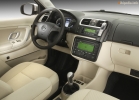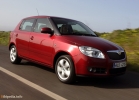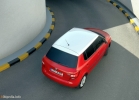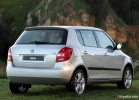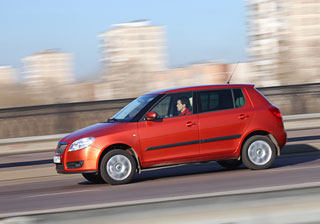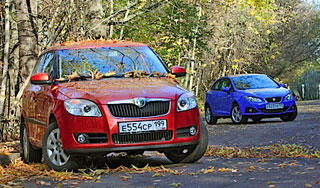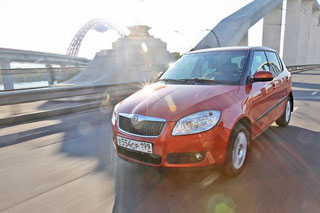Skoda Fabia test drive since 2007 -
Do not be afraid of Fabia
 Many customers bypass small cars not only because of the tightness, but also fearing their short-lived. As the smallest Skoda behaves in operation, Igor Kozlov found out.
Many customers bypass small cars not only because of the tightness, but also fearing their short-lived. As the smallest Skoda behaves in operation, Igor Kozlov found out. In the late 90s, the Czech brand made his way to the leaders of the Russian market, but Fabia could not even approach her predecessor Felicia in popularity. Alas, the younger sister of Volkswagen has risen in price noticeably, and in the secondary market is not cheap: for a car of 2000 they ask for $ 8,000, for a two -year -old from $ 11,000.
Sninching
The corrosion resistance of the Fabia body is higher than Felicia. However, the fifth door is still a weak link: from our salt and other anti-altogether compositions of rye can bloom after three seasons around the lining of a handle and a lock, and also on a combi near the rear window. Do not leave the car for a long time with a unwashed body, especially in a warm garage: the mud-salt compress noticeably accelerates corrosion. There was also peeling of paint on the eyebrows of wheeled arches: regular plastic shelves do not protect their ends. It is better not to wait for chips and treat the ends with anti -gravity.
Salt and gum do not spare. Stabilizer bushings in the front suspension require replacement almost after every winter. Silent-blocks are more tenacious, but for them, according to the observations of the dealer, old age determines not a run, but the number of wintering is usually three or four. Perhaps it is guilty of early resignation of not only salt, but also the overload of hinges, and a significant temperature difference (a power unit is located nearby). Fabia with a 1.2 l engine has a more rare phenomenon (this engine is easier than 1.4-liter by almost 15 kg), and in the rear suspension, away from hot units, there are no such problems at all.
 CHAIN \u200b\u200bREACTION
CHAIN \u200b\u200bREACTION Three-cylinder 12-valve engine 1.2 liters, 64 liters. With. (BMD, BME or AZQ index) went to Fabia from Volkswagen-Polo. Such cars are distinguished by an HTP nameplate with a dedicated letter P (High Torque Performance High -Mom -Moping Engine). The main problem is the early stretching of the timing chain. It is cheaper to treat extraneous noise by adding the volume of music, but by replacing parts: in advanced cases, the case often ends with the repair of the head of the block. When replacing the circuit, we check the condition of its water supply, and a number of the lower engine is disassembled, then a separate chain drive of the oil pump, although it is most often in order. Cars with a simpler AWY engine (two valves per cylinder, 1.2 l, 54 hp) carry a regular HTP nameplate. Problems with a chain on these engines are much smaller.
In engines 1.4 liters, 101 l. With. With AUB or BBZ indexes (on the back of the red nameplate 16V), another trouble: due to the large content of the resins in the domestic fuel, the valves rods are covered with sediments and can hang in the guides. The consequences are sad expensive repairs with the replacement of bent valves and holey pistons. To reduce the likelihood of a breakdown, it is advisable to rinse the nozzles without dismantling each other (on a running engine); In this case, the valve rods are also cleaned. Also try to avoid short trips with an unfinished engine. If you have to ride long distances, then it can be washed less often through one, or even two then: with prolonged increased resin loads and foggers are partially eliminated.
 Motors 1.4 liters, 74 l. With. (AUA, BBY or BKY index) differ not only in the color of the 16V nameplate on the body; Their valves freeze less often. And on older AME, ATZ and AQV engines (68 hp) and Aze, AZF (60 hp), there are no these problems at all. The tenacious old liter ARV and AQV (50 l.), Although we have such motors is a rarity.
Motors 1.4 liters, 74 l. With. (AUA, BBY or BKY index) differ not only in the color of the 16V nameplate on the body; Their valves freeze less often. And on older AME, ATZ and AQV engines (68 hp) and Aze, AZF (60 hp), there are no these problems at all. The tenacious old liter ARV and AQV (50 l.), Although we have such motors is a rarity. But charged Fabia are even more rare in our market: with a 2-liter gasoline engine (on the body of the MPI nameplate) and a modification of RS with a turbodiesel of 1.9 liters, 96 kW/131 liters. With. You rarely find other diesel versions with a capacity of 64 to 101 liters. S.: At the time of preparation of the material of ads for the sale of such machines, there were no. There is no objective information about their reliability in Russia, and most importantly, the dealer in warehouses has almost no spare parts. Any trifle will have to order and put up with considerable terms of delivery.
SECOND LIFE
The weak place of gasoline engines is a throttle node. Over time, the paths of the potentiometer we wear out at the sensor of the throttle position, which is why its output voltage changes. The controller ceases to understand the situation when the damper is closed. The mechanical wear of the axis exacerbates the situation. An unaccounted air is sucked through this gap into the inlet collector, to the extra portions of which the engine is especially sensitive in idle and small throttle modes. As a result, the engine works unevenly on the idle, with a slight press on the pedal, he twitches, and with a sharp discharge of gas, it may completely stall.
You can cure the ailment to replace the node, but it is not cheap. It is better to visit specialists and using the VAS 5051/5052 diagnostic complex to introduce the engine control unit with the changed parameters of the old throttle node. The resource of alteration and new details is almost the same about 40 thousand km, if lucky, then 6070 thousand.
But the ignition coils, alas, can not be returned: when interruption in ignition and bluish halo around the high -voltage output, the verdict is unambiguous replacement. More often this happens in the warranty period, but later refusals occurred. It is better not to delay with the replacement, a neutralizer that is unburned in the cylinders can destroy the fuel.
 Who to work, who to run over
Who to work, who to run over Mechanical gearboxes are quite reliable. But the clutch is not famous for the durability, often it is already changed at a run of 3040 thousand km. With a machine gun the only trouble does not have a probe for controlling the oil level. Instead, a plug is in the crankcase, and the level is checked at each technological probe. This idea is not new, but inappropriate for Russian expanses with a meager service. If you often go beyond the boundaries of civilization, spy on the dealer the size of the probe and make an analogue, for example, from an old speedometer cable.
The main drawback of electrical equipment is a frail generator that issues only 70 A, which only recently gave way to a more powerful 90-ampere. In the conditions of a city-nich-winter-excavation, a wimp cannot fully recharge the battery, as a result (as a rule, at the peak of winter) there are difficulties with starting. Take the rule of periodically recharge the battery from an external source. This is especially true for versions with an electric packet, where energy consumption is greater.
If in the car of the car with air conditioning there is no coveted coolness, the evaporator temperature sensor is often guilty of this, and not the refrigerant leaks are not typical for Fabia.
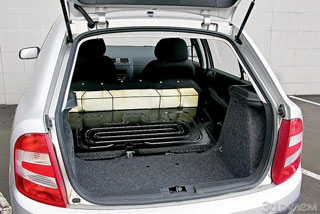 There are no problems with a full -time immobilizer, unless, of course, lose the key. The new one will cost in 19502800 rubles. And more than a month of waiting (he is taken from Austria). You can buy a blank in the market for 500 rubles, but it happened that the chip in the head of such a key turned out to be invisible to the diagnostic complex VAS 5051/5052, with which the beginner was introduced to the immobilizer of the machine.
There are no problems with a full -time immobilizer, unless, of course, lose the key. The new one will cost in 19502800 rubles. And more than a month of waiting (he is taken from Austria). You can buy a blank in the market for 500 rubles, but it happened that the chip in the head of such a key turned out to be invisible to the diagnostic complex VAS 5051/5052, with which the beginner was introduced to the immobilizer of the machine. A dense layout of the engine compartment is fraught with a catch: the neck of the tank of the steering wheel under the left headlight in the depth of the compartment is inconveniently located. When refueling a liquid or a level control, be sure to wipe the surface of the sprayer and nearby parts! Otherwise, the dirt from them crumbles into an open tank, which will reduce the resource of the mechanism.
In general, the Skodovites took possession of the art of creating small forms. By the way, according to TU..V, Fabia, hardness, firm middle peasants in terms of reliability: two-three-year-olds occupy 38th place out of 113 analyzed, and four to five-year-olds 47th.
The history of the model
1999 Debut at the Frankfurt Motor Show. The body is a five -door hatchback. Engines: gasoline P3, 1.0 liters, 37 kW/50 hp.; P4, 1.4 l, 44 kW/ 60 hp or 50 kW/68 l. With. (differences in the settings); P4, 2.0 l, 85 kW/116 l. With.; diesel p4, 1.9 l, 47 kW/64 hp or 74 kW/ 101 hp (accordingly, atmospheric and with turbocharged). Front drive, M5.
2000. Modification of combi (station wagon). EURONCAP Crash Test: 4 stars, 12 and 14 points for the front and lateral blow, respectively.
2001 Sedan. New gasoline engines: P4, 1.4 liters, 55 kW/75 hp. or 74 kW/101 hp (differences in the settings). Four -speed automatic only with a motor
55 kW.
2003 New engines: gasoline P3, 1.2 l, 40 kW/ 54 hp. and p3, 1.2 l, 47 kW/ 64 hp (respectively 6- and 12-valve); Diesel with a Bosch EDC injection system and turbocharged: P3, 1.4 liters, 51 kW/ 69 hp or 59 kW/80 hp (with additional cooling of air at the inlet). RS modification with a diesel engine with a pump-adjustable turbine apparatus and with additional cooling of air at the inlet P4, 1.9 l, 96 kW/131 hp. (only with the new M6).
2007 at the factory in Mlada-Boylav, the release of Fabia of the second generation was launched.
Source: The magazine "Driving"
Video Skoda Fabia test drive since 2007
Video crash tests Skoda Fabia since 2007
Skoda Fabia test drive since 2007
Skoda Fabia crash test since 2007
Krassh Test: Detailed Information32%
Driver and passengers
17%
Pedestrians
36%
Children-passengers
Skoda Fabia faults since 2007
Skoda Fabia malfunctions: Detailed information| Fabia since 2007 | |
|---|---|
| Engine |  |
| Transmission |  |
| Control system and suspension |  |
| Brake system |  |
| Air heating and air conditioning |  |
| Launch and charging system |  |
| Electric components and so on |  |
| Corrosion body stability |  |


